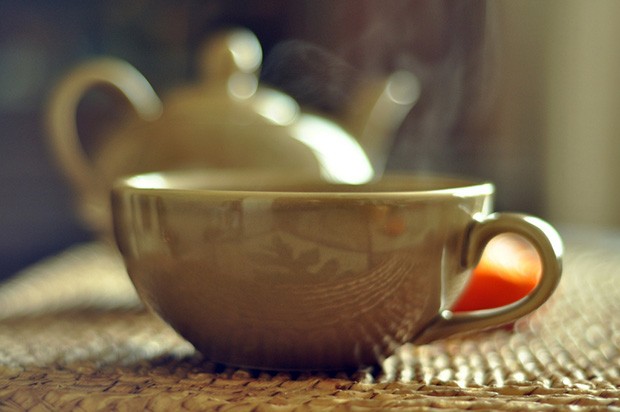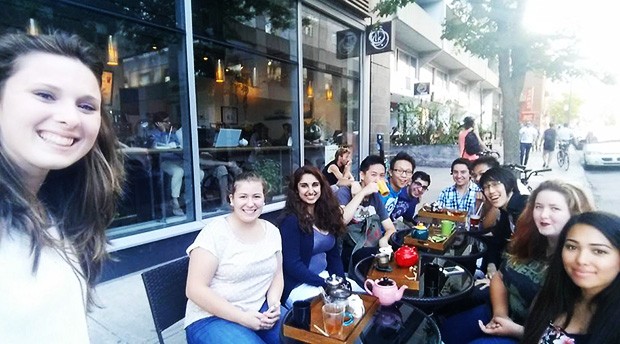Tea for 200
 “Tea is love, tea is life.” | Photo by Flood G (Flickr CC)
“Tea is love, tea is life.” | Photo by Flood G (Flickr CC)
Puffs of steam waft from Shalani Sridhar’s cup as she explains in between sips how her extensive tea collection has grown into a full-scale wall over the years. It’s both a reminder of her native Sri Lanka — one of the world’s largest producers of the beverage — as well as a testament to the hot drink she loves most.
Her adoration of tea coupled with the desire to make new friends led her to the Concordia University Tea Enthusiast Association, a crew of more than 200 pekoe-praising students who playfully refer to each other as CUTEAs.
“It’s about building social interaction and a sense of community,” says Shai Marshall, who co-founded the club last year, as he pours a cup of German vanilla crème tea from a glass vat. “It’s so much more than just a drink, it has such a rich history.”
“There are so many flavours, so many health benefits too,” adds Sridhar, one of the club’s newest members.
Steeped in history
As diverse — an estimated 1,500 types — as it is storied, tea traces its origins back thousands of years to a moment of divine intervention.
Chinese emperor Shennong was boiling some water under a camellia tree when a few leaves blew into his cup.
Fast forward 4,752 years and the accidental discovery is now the world’s most widely consumed drink after water, and can be found in virtually every corner of the globe.
“It’s a very simple thing — a couple of leaves in boiling water — but it has a vibe,” says Marshall. “Tea is about stopping and pausing whereas coffee is about getting up and going. As tea steeps you relax for a moment, reflect and talk about things.”

Tea vs. coffee
Marshall admits he wasn’t always a tea aficionado. Once a java addict, he says coffee’s feel is different, frenetic and tense, citing the advent of drive-throughs as evidence of its on-the-go culture.
“Tea gives you a more subtle, calm energy, and you don’t crash like you do with coffee. I definitely think more students should make the switch from coffee to tea, especially around midterms.”
While Marshall might be biased, he’s not wrong. Popular research supports his contention that tea offers a low-key energy.
That’s because tea is a mental stimulant that also tranquilizes. Its effect on the brain is due to a combination of psychoactive properties found in the leaves of the Camellia sinensis shrub, from which all tea is made.
The leaves contain caffeine, which stimulates the central nervous system, improving mental performance by sharpening concentration, attention and alertness.
However, unlike coffee, tea offers a longer-lasting high without triggering an intense energy slump afterwards. This is thanks in part to theanine, an amino acid almost exclusive to tea. Theanine increases the brain’s generation of alpha waves and gamma-aminobutyric acid, both of which are associated with deep relaxation, sensations of pleasure and mental clarity.
So the same sip can perk you up and calm you down.
The ritual of tea
Gabriella Szabo, health promotion specialist at Concordia, says one of the most important health benefits of tea might be its meditative qualities, which can be especially good for stress-addled students.
“In many cultures when people embrace each other they offer tea,” says Szabo. “Through it, people peel themselves away from their busy lives by consciously making something to comfort and soothe themselves, or to show warmth and kindness to the people they care about. We need more of these rituals in our lives, in which we intentionally recover.”
Founding member Frances Zsurka says she hopes to see the Concordia University Tea Enthusiast Association become the go-to place for new students who — like herself when she first came to Concordia — don’t yet have many friends at the university.
“It’s a club for people to hang out, have discussions and make friends with all sorts of people from other nationalities, hobbies and majors.”
“Tea is love, tea is life,” Sridhar says, cup in hand.
8 top picks from CUTEAs
Hong Kong milk tea is brewed in a large tea sock. Smooth and creamy in texture, it can be made with condensed milk for extra sweetness. Cocobun at the Guy metro exit downtown sells cups for $2.
Lapsang souchong is a black tea from the Fujian province of China, renowned for its smoky aroma, due its leaves being dried over pinewood fires. You can pick up 50 milligrams for $6 at CAESARSTEA on Ste-Catherine Street West.
Yuanyang, also known as coffee milk tea, is a popular beverage in Hong Kong. Three parts coffee and seven parts Hong Kong–style milk tea, this is a good option for those who need a jolt of caffeine. You can find this drink in Chinatown.
Grass jelly roasted milk tea, a liquid dessert commonly found in China, Taiwan and Southeast Asia, is a blend of tea with milk and grass jelly. You can pick one up for $4.20 at Chatime, which has three stores in Montreal.
Vanilla and pear is a white tea that can be bought online at Ariel Tea or at its headquarters, 290 Port-Royal Street West — a 10-minute walk from Sauvé metro station.
Assam and Keemun are good black tea options for purists who enjoy a full-bodied cup. They are available at uptontea.com, which also carries foil bags that are excellent for storage.
Milky oolong, known for its smooth and creamy flavour, is ideal for multiple infusions with a long-lasting orchid aftertaste. You can pick some up at one of My Cup of Tea’s three Montreal locations.
BONUS: Here’s a do-it-yourself masala chai recipe, though note that "bay leaf" refers to Indian bay leaf (a plant that tastes like cinnamon).
Find out more about how become a member of the Concordia University Tea Enthusiast Association (CUTEA).